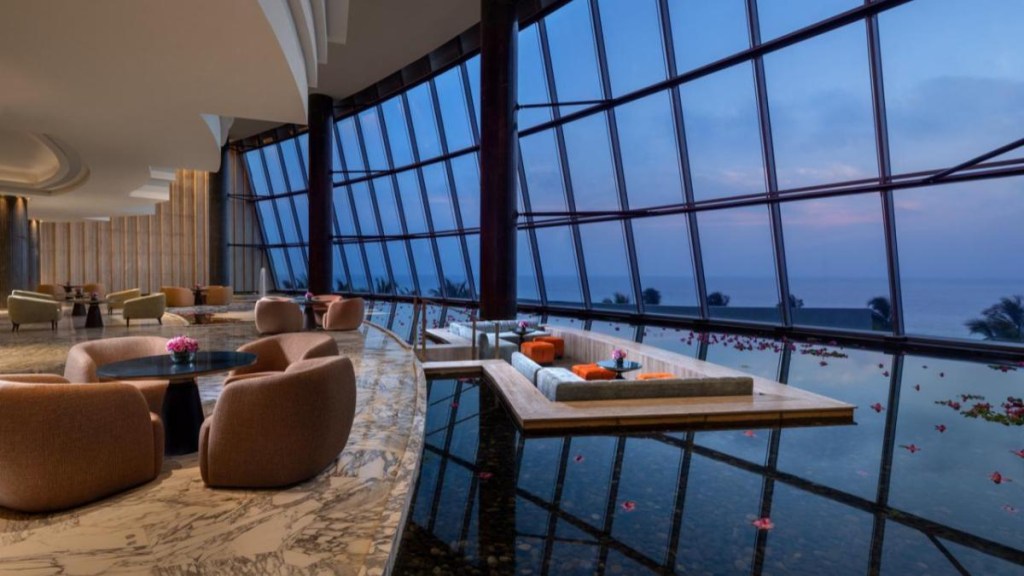Just a few minutes’ drive from renowned colonial architect Geoffrey Bawa’s heritage house in Colombo are futuristic twin towers connected by a sky bridge, the ITC Ratnadipa, the Indian hotel major’s first international property that was inaugurated on Thursday.
The ultra-modern steel and glass building symbolises not just the nation’s journey from a colonial past to a modern present, but also much-needed development. As the twin towers rub shoulders with the biggest international, Indian, and Sri Lankan hospitality brands on Galle Face, the area could well be mistaken for a Macau strip at night.
As Sri Lankan president Ranil Wickremesinghe said at the launch: “All these hotel brands in one line are now a symbol of Colombo, and the presence of ITC is symbolic of India’s commitment to Sri Lanka.” This was echoed by Indian high commissioner to Sri Lanka Santosh Jha as he said, “India is an economic partner of Sri Lanka, and such investments are emblematic of India’s support to Sri Lanka, through thick or thin.”
Slated to open in 2017 after the groundbreaking took place in November 2014, the hotel finally opened its doors in a glittering ceremony attended by the Sri Lankan president, PM Dinesh Gunewardena, cabinet ministers and members of parliament.
Built at a cost of about $500 million, the hotel has been set up under WelcomHotels Lanka, a subsidiary of ITC, and is one of the company’s largest investments. Claiming to have the best location in the capital city, ITC chairman and MD Sanjiv Puri said Colombo was a natural choice for the diversified conglomerate’s first foreign hospitality foray as tourism is growing at an unprecedented pace in the region and the property will focus largely on MICE, with good conferencing and banqueting facilities.
The modern design was a conscious choice by ITC, with Puri saying it is an “engineering marvel with a triangular design that enables spectacular views of the ocean”. But then the brand has always gone big when it comes to its luxury properties, be it the palatial Grand Chola right in the middle of Chennai, the veritable township of Grand Bharat on the outskirts of Delhi, the expansive towers of Royal Bengal in Kolkata or the edgy Kohenur in Hyderabad.
The smaller tower houses the hotel, while the larger houses the 132 Sapphire Residences, which, Puri said, will be for sale, and to be serviced by the hotel. Residences within hotels is a post-pandemic trend that has picked up fast. While new constructions incorporate them from inception, several iconic hotels have been revamped to include residences.
The two towers of ITC Ratnadipa are connected by Ahasa One, a 55-metres sky bridge 100 metre above ground, the first in south Asia, constructed by Larsen & Toubro.
The project reportedly received strategic investment status from the Sri Lankan government, besides tax breaks. Allotted 5.86 acres of land, the project is also exempt from foreign exchange regulations.
On an expansion spree with a target to reach 200 properties in the next five years, ITC opened 22 properties in the past two years (January 2022-December 2023), and has 25 more in the pipeline, most of which will be management contracts, in the next two. In August last year, ITC approved the demerger of its hotels vertical, with a listing expected within 15 months.
Besides ITC, several hospitality projects opened in Sri Lanka recently. These include Hilton’s resort near Yala National Park and a Sheraton property in Colombo by Marriott. As per reports, tourism minister Harin Fernando recently disclosed a return of the Intercontinental to the island nation as well. Marriott’s Ritz Carlton, a three-tower project located in the same area as ITC Ratnadipa, stands close to completion. Indian hospitality brand IHCL already operates two luxury properties under the Taj brand and one under Vivanta in Sri Lanka.
The writer was in Colombo at the invitation of ITC Hotels.

